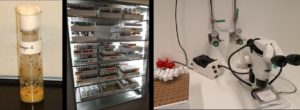Drosophila Melanogaster, the fruit fly.
Small in size but large in contribution to our understanding of numerous human diseases the fruit fly has played a leading role in the fields of developmental biology, genetics, cancer, and cell biology, to name just a few of the areas in which it has excelled. It’s smaller and more compact genome when compared to other common model systems (fish, mouse, human cells) while still containing 75% of all human disease-related genes, has contributed to its attractiveness as a genetic model. The small fruit fly has a wide variety of genetic tools, more advanced than those of rival model systems, at its disposal, following over 100 years of use as a model system. Additionally, the ability to image all tissues during their development, coupled with the range of genetic manipulations possible gives a model system in which a gene or protein function can be assessed at a cell, organ and whole animal level with ease and speed. Welcome to the world of fly genetics where seeing is believing!

Images from the fly facility: Left to right; A tube containing fly food and all stages of fly life-cycle (embryo, larvae, pupae and adults). The food is a mix of potato, yeast and sugar; Middle, tubes of flies are stored in racks (up 100 in each) placed in incubators that run at 18 or 25oC (at 18oC the life cycle is extended by 100%, suited for stock maintenance); Right, A stereo microscope, light source and a CO2 stage and CO2 gas regulatory system. The CO2 gas is dispersed very locally at low amounts, but sufficient to put the flies asleep. We can then use the scope to sort out flies, typically sorting males from females for controlled crossing later, but also looking for phenotypes/visible markers. Placing the flies back into vials, away from the CO2 gas lets them wake up again. Not shown in picture is a portable lamp capable of exciting fluorescence to select for Green and Red fluorescent proteins GFP/RFP expression.
For a students perspective check out Nora Solheims blog! Available in Norwegian only.